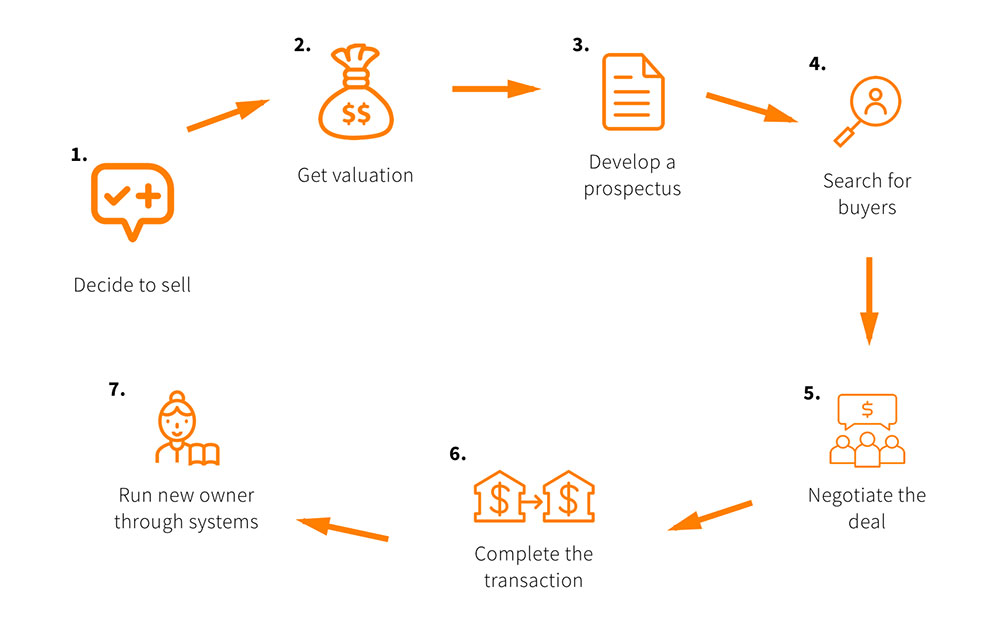Start at Part 1 of this 5 part series.
So what do you need to do in order to sell your Amazon business? Below, we look at a general overview of what the selling process might look like, and how this works when a good broker is involved.
General overview of selling process

- You decide to sell your FBA business.
- Get a valuation for your business.
- Develop a prospectus – providing an overview of how the business operates, financial information, market analysis etc.
- Search for buyers of the business.
- Negotiate a deal with potential buyers – agree upon a price, terms etc.
- Complete the transaction. Transfer the assets of the business to the buyer, and receive payment for the business (payment is often held in Escrow until the buyer is satisfied that they have received what they expected).
- Run the new owner through the systems and train them to operate the business.
Selling process through a good broker
The selling process listed below is an abbreviated version of the process covered in detail in this top quality guide by Quiet Light Brokerage. If you are thinking about selling your FBA business through a broker, this guide is definitely worth a read. Not all brokers will follow this exact process – they all have a different way of doing things. However, as a starting point, it does provide valuable information:
- Produce clean financials:
- As discussed above, A2X Accounting software makes this task a breeze for FBA businesses.
- Once your accounts are clean and easy to understand, create an addback schedule to determine SDE.
- Determine the “value range” – multiple of SDE range that can be expected from sale of the business:
- Your broker can help you to estimate how much your FBA business is worth. Refer to section 3 of this guide for more information on factors that affect the value range.
- Determine costs/benefits of selling your business:
- Costs that are incurred when selling your business include broker’s commission, legal fees and taxes.
- Tax is generally payable on the proceeds from selling your business. Tax is not paid on inventory sold at cost.
- Consult professionals where required to get accurate advice.
- Sign an engagement letter between business owner and the broker:
- Guarantees a period where the broker has the exclusive right to sell the business. What really matters is the relationship between you and the broker. 90 days is an appropriate period of time, however this may vary depending on the nature of the business, and relationship between you and the broker.
- Some brokers try to win your business by offering non-exclusive agreements, but this often turns sour, with multiple brokers fighting over who gets the commission.
- Develop a marketing package/prospectus:
- This is an in-depth overview of how your business operates and the financials.
- Potential buyers must sign an NDA first – confidentiality is key.
- Good brokers often do an in-depth client interview to understand history of the business, threats and opportunities, hiccups, trends and what the business represents in your eyes.
- Using this information, they can draw up a vision for where the business is going and answer many of the common questions that may arise during due diligence. This streamlines the sale process and reduces the amount of questions that you have to answer later on when buyers are asking questions about every issue that concerns them.
- Buyer conference calls
- Before accepting a letter of intent (LOI), a buyer and seller have a conference call – to get to know each other and understand more about the business. This is to make sure you are doing business with someone that you know, and feel comfortable to move forward with.
- Letter of intent
- A letter of intent is the first step in a written commitment for a buyer to purchase your business. The purpose of this letter is to act as a framework for the final and binding purchase agreement. It allows for the buyer to conduct due diligence and explains the agreement in clear and simple language.
- The letter of intent is a non-binding agreement which is seldom checked by lawyers.
- If the buyer is satisfied, then an asset purchase agreement will be created to create a legally binding transaction that transfers the assets of the business.
- A typical time period from signing the letter of intent to agreeing on the asset purchase agreement and closing the deal is 30-40 days.
- Due diligence
- This is the time to verify (through third parties) that the information provided is in fact, correct. The buyer will reproduce the profit and loss statement from third party data (such as Amazon stats), and check a number of other things (such as: financial statements, agreements with vendors and contractors, registration of the business, relevant licenses, making sure that there are no open lawsuits against the company etc.).
- Some suppliers will try to renegotiate terms that are more favourable to them and less favourable to the buyer when they hear that the business is being sold. Buyers will seek verification that they can enjoy the same payment terms, discounts etc.
- As a seller, you want to make this process as straightforward and simple for your buyer as possible, as this represents a major potential roadblock.
- Buyers generally produce a due diligence request list – information that they require from you to conduct their due diligence.
- If there is any discrepancy between the earnings and what the buyer calculates the earnings to be, the buyer will either walk, or you will have to reduce your price by the difference in earnings x valuation multiple (e.g: if there is a $10,000 discrepancy and your valuation multiple is 3x, the buyer would expect a $30,000 discount). You can say no to providing a discount, but this will generally result in the buyer backing out of the deal.
- Asset purchase agreement
- Once the asset purchase agreement is signed, the transfer can be completed.
- The buyer sends money to an escrow operated by a lawyer, or another 3rd party escrow service such as escrow.com.
10. Closing, transition and training
- Assets that are listed in the asset purchase agreement are transferred to the buyer’s business entity.
- Unlike selling a bricks and mortar business or a house, this process is largely done directly between buyer and seller. Most of the asset transfers are done remotely – items such as the Amazon Seller Central account, social media accounts and business webpages are transferred online, so there doesn’t necessarily need to be a physical meeting between you and the buyer.
- For training and transitioning, sellers will generally offer up to 40 hours of service within the first 90 days. However, this can vary depending on the complexity of the business.
- Training and transitioning most often happens via telephone, screenshare and email. Sometimes, training happens in person, however this is quite rare.
- Generally, buyers don’t need all 40 hours, as running an Amazon business is very easy once set up. It is recommended that both parties keep a record of the time consumed with training to avoid any disputes.
PRACTICAL CONSIDERATIONS ASSOCIATED WITH SELLING YOUR FBA BUSINESS
Am I allowed to sell my Amazon business?
This is an interesting topic, which is important that we discuss in this guide. Amazon states on their website that
“Seller accounts are not [generally] transferable. Seller accounts provide access to the tools sellers use to list their products, manage their orders and utilize resources that Amazon makes available to sellers. Seller accounts also include account activity history and customer feedback. Every seller on Amazon.com must have a seller account and an agreement with Amazon that establishes the terms under which the seller lists and sells its products. If the ownership of a business changes for any reason, the new owner should establish a new seller account. If the ownership of your business isn’t changing but the individuals responsible for management of your seller account have changed, you can add additional users to your account” Link
Amazon restricts the ability to transfer control of seller accounts for a number of reasons. For starters, it prevents sellers that have previously been banned from Amazon from operating new accounts. Another important reason that Amazon restricts account transfers is to create a fairer basis for competition. When a seller has a great reputation, it is because they have earned that reputation – there are no guarantees for consumers that the new seller will have the same reputation.
However, the issue of transferability is not quite ‘black and white’. For example, there are large publicly listed companies selling products on Amazon that change ownership many times every day, but they don’t need to establish a new seller account every time someone buys or sells their shares. In the past few years, thousands of FBA businesses have been bought and sold, and Amazon has allowed this to happen. If you are planning to sell your FBA business, and want to be sure that there will be no hiccups down the line, we recommend that you contact Amazon to seek written approval, just like the team at Quiet Light Brokerage did.
Non-compete clause
The agreement which binds the sale of the business is a negotiable contract. Although buyers will want to ensure that you don’t compete directly with them following the sale of your business, they usually won’t mind if you continue selling other products on Amazon that aren’t competing with their business interests. However, if this is a consideration for you, it is important to include this in the sale and purchase agreement to prevent future disputes.
What is involved in transferring ownership of the business?
Any assets of the business will be transferred to the new owner as per the terms of the contract. This includes the Amazon Seller Central account, any stock, domain names, email addresses, trademarks and copyrights and social media pages. Buyers will take on the assets of the business, but will not assume existing liabilities.
Suppliers need to be notified of the change of ownership, and introductions made. For larger businesses, this might involve a physical visit and shaking of hands. For smaller businesses, introductions can take place via skype, email or other digital means of communication.
Congratulations! You have made it to the end of our “How To Sell Your Amazon Business” guide.
We hope that you have learned lots about where, how, why and when to sell your Amazon business. A key theme throughout this guide is that automating processes is extremely important. In fact, with all of the resources that we have at our disposal in our modern world, outsourcing and automation is potentially one of the greatest game changers for e-commerce. By using Fulfillment by Amazon, you can remove the requirement to physically hold stock and manage operations. With A2X Accounting, you can automate the financial side of your business and make operations a breeze.










